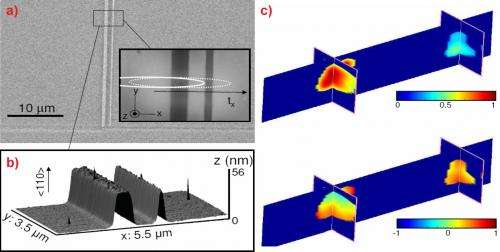New technique to see crystals like never before

An international team of scientists led by the Fresnel Institute and the ESRF (European Synchrotron Radiation Facility) in Grenoble has developed a new technique allowing to observe the nanometer-sized structure of crystalline materials. Using a microscopic X-ray beam to illuminate large areas of a sample, this technique reveals structural details in three dimensions and at high resolution. It could revolutionize research in various disciplines involving the study of complex crystal structures, such as the life sciences and microelectronics. This work is published in the journal Nature Communications on November 29, 2011.
So far, two techniques were used to analyze complex crystalline materials, but they have their limitations. Classic "X-ray diffraction" makes it possible to obtain information concerning irregularities in a sample without damaging it, but with a limited spatial resolution, in the micrometer range. Transmission electron microscopy (TEM), on the other hand, exhibits a much better spatial resolution (0.1 nm), providing a "real" image of the crystal, but it destroys the sample.
The new technique developed by Virginia Chamard and her colleagues at the Fresnel Institute overcomes these limitations by combining the advantages of both methods: it produces high-resolution 3D images – down to a few tens of nanometers - without destroying the sample, and it provides as much information on its atomic structure as conventional X-ray diffraction. In addition, it makes it possible to analyze very large areas, of potentially infinite dimensions, which has never been achieved before.
This technique relies on a microscopic X-ray beam produced by a synchrotron—for their work, researchers used the European Synchrotron Radiation Facility (ESRF) in Grenoble—and focuses it on the sample. As the beam scans across the sample, a detector captures the intensity of the diffracted X-rays and provides a series of "diffraction patterns". These are processed by a special algorithm that generates a 3D image of the entire sample with a resolution smaller than the width of the X-ray beam.
The foundations of this technique called "ptychography" were laid in 1969 by German physicist Walter Hoppe who invented it to improve the resolution of electron microscopy. It took Virginie Chamard and her team three years of work to adapt his method to crystal imaging.
This new technique is crucial to address major scientific and technological issues. These include understanding shellfish growth, controlling semiconductors' optical properties or improving the electrical performance of metal alloys, all of which are complex crystalline materials. Such feats have now become possible.
More information: Three-dimensional high-resolution quantitative microscopy of extended crystals, P. Godard et al., Nature Communications, November 29, 2011.
Journal information: Nature Communications
Provided by CNRS
















